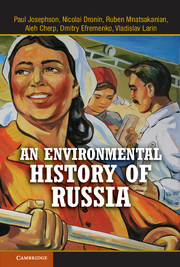Book contents
- Frontmatter
- Contents
- Introduction
- 1 From Imperial to Socialist Nature Preservation
- 2 Stalinism
- 3 The Khrushchev Reforms, Environmental Politics, and the Awakening of Environmentalism, 1953–1964
- 4 Developed Socialism, Environmental Degradation, and the Time of Economic “Stagnation,” 1964–1985
- 5 Gorbachev's Reforms, Glasnost, and Econationalism
- Conclusion After the Breakup of the Soviet Union
- Index
- References
Conclusion - After the Breakup of the Soviet Union
Inheriting the Environmental Legacy
Published online by Cambridge University Press: 05 April 2013
- Frontmatter
- Contents
- Introduction
- 1 From Imperial to Socialist Nature Preservation
- 2 Stalinism
- 3 The Khrushchev Reforms, Environmental Politics, and the Awakening of Environmentalism, 1953–1964
- 4 Developed Socialism, Environmental Degradation, and the Time of Economic “Stagnation,” 1964–1985
- 5 Gorbachev's Reforms, Glasnost, and Econationalism
- Conclusion After the Breakup of the Soviet Union
- Index
- References
Summary
Symbolic of the Soviet environmental legacy, the sarcophagus that encases Chernobyl reactor number 4 is crumbling. Built heroically yet hastily under dreadfully dangerous circumstances, it is unlikely that it will outlive typical aging processes of any concrete. In spite of efforts to strengthen it, it may collapse, leading to the release of tons of radioactive dust. The European Union (EU) and the United States agreed to provide the perhaps $2 billion needed to build a new sarcophagus for the reactor – 325 feet tall, 800 feet wide, and 475 feet long. Construction has been delayed several times and it is unclear when it will be completed. This would permit the first entombment to be dismantled and all remaining nuclear fuel to be removed from the site. The entire station, closed for years, with unfinished cooling towers of additional planned reactors, serves as a ghostly reminder of the costs of pushing ahead to produce electricity without circumspectly considering the social and environmental costs of development. Yet around the station and in the exclusion zone, wild horse, boar, lynx, and wolf populations have returned to the area, and birds are even nesting in the reactor building without any obvious ill effects. This suggests how the zone has become a vibrant ecosystem when sealed off from general human use. But, of course, nature exists only in interaction with human beings.
- Type
- Chapter
- Information
- An Environmental History of Russia , pp. 287 - 320Publisher: Cambridge University PressPrint publication year: 2013



